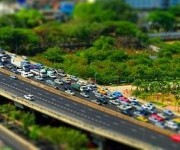Photo: Cyril PlapiedCross-posted from Sightline Daily.
Tuesday’s news carries a story that I’ve been expecting for a while: Connecting Washington, a task force convened by Washington’s governor, has called for $21 billion in new transportation investments over the next 10 years. I haven’t seen the recommendations themselves, only the news report. But it looks like the money would get spread around a bit — with some for ferries and some for transit — but from what I can gather, most of the money would be slated for roads.
So in the upcoming months, I expect we’ll be hearing a lot about how investing in new roads will help clear up traffic problems, particularly in greater Seattle and the Washington side of greater Portland.
But a study that’s been sitting on my desktop for a while — which I count as the single most interesting transportation paper [PDF] I ran across all year — suggests otherwise. Co-authored by researchers Gilles Duranton and Matthew A. Turner from the University of Toronto, it’s a careful and remarkably thorough analysis of the relationship between urban highway space and traffic volumes in the U.S. And its key finding is straightforward:
For interstate highways in the densest parts of metropolitan areas, we find that vehicle kilometers traveled [vkt] increases in exact proportion to highways.
In short, the authors find that building new urban highways simply increases traffic volumes — not in some general, intuitive sense, but in the sense that a 1 percent increase in urban highway space increases urban road travel by precisely 1 percent.
To many folks who follow transportation issues closely, the idea that new roads create new traffic is familiar — yet it sometimes gets bandied about rather casually, as if it’s something that we know but don’t particularly need to prove. But there’s nothing casual about Duranton and Turner’s analysis. It’s thorough, well-thought out, rigorous, employs careful controls to separate cause from effect, and uses the best available data for the U.S. transportation system from (I kid you not) 1835 to the present.
And while road skeptics will undoubtedly be heartened by the findings about highways and traffic, they may be troubled by another of the study’s findings: Public transit has virtually no effect on traffic volumes.
The irrelevance of transit service to urban traffic volumes goes against both intuitions and the claims of many transit analysts. Yes, it’s easy enough to argue that if all transit riders started driving, then they’d clog the roads during rush hour; and conversely, that if a bunch of people switched from cars to buses, rush-hour traffic would get lighter for awhile. But as the authors point out, if drivers switch from cars to buses or trains, it has much the same effect as adding new road space: Traffic clears up temporarily, but faster travel quickly attracts more drivers who take longer trips.
And just to be clear — and before the haters start hatin’ — the authors aren’t arguing that transit is irrelevant to transportation, or that it has no value to society. I certainly believe that transit has substantial value for people who can’t afford a car, can’t drive, prefer not to spend their time behind the wheel, or want to live in a place where road space is constrained. Saying that transit doesn’t have much systemic impact on congestion isn’t the same as saying that transit isn’t a good idea!
So if this study is accurate, then it poses some serious problems for transportation compromises that couple road expansions with transit projects. It’s easy to convince yourself that those kinds of compromises are win-wins — that road expansions will simply ease congestion, and that transit will help keep traffic growth in check. But this research suggests that that sort of compromise is a pipe dream. What matters to highway vehicle miles traveled, according to Duranton and Turner, is how much free road space we create. Just about everything else is a distraction.
I’ll leave the technical details to the avid reader (you really should read it! [PDF]) and simply pull out two quotes that explain some of the the other implications of the research.
We find that the welfare gains for drivers of building more highways are well below the costs of building these highways. This conclusion follows, not from the high elasticity of vkt to roads, but from the fact that new roads do not reduce the cost of travel sufficiently.
Road projects are sometimes sold to the public based on promises that easing traffic congestion will save everyone time. But the study finds that these congestion reductions are short lived at best. The additional people on the road get some value from their trips (otherwise they wouldn’t make them!), but for society as a whole, they find that the cost of new roads tends to outweigh the benefits.
We … identify three important sources for this extra vkt: an increase in driving by current residents; an increase in transportation intensive production activity; and an inflow of new residents.
Interestingly, they find that boosting driving among existing road users is only one way that new roads can induce new traffic. Road space also changes the mix of businesses in a metro area, with more road space leading to more driving-intensive businesses; and they even find that lower commuting costs can attract new residents. The latter effect is small — they find that a 10 percent increase in road space can lead to a 1.3 percent increase in population over a decade, all else being equal — but still significant.
I certainly don’t mean to hold up this study as definitive. It’s only one piece of evidence among many on the effects of transit and road construction on traffic. Yet it’s a particularly well-researched piece — one that folks looking to understand transportation (rather than simply argue about it) would be unwise to ignore.



